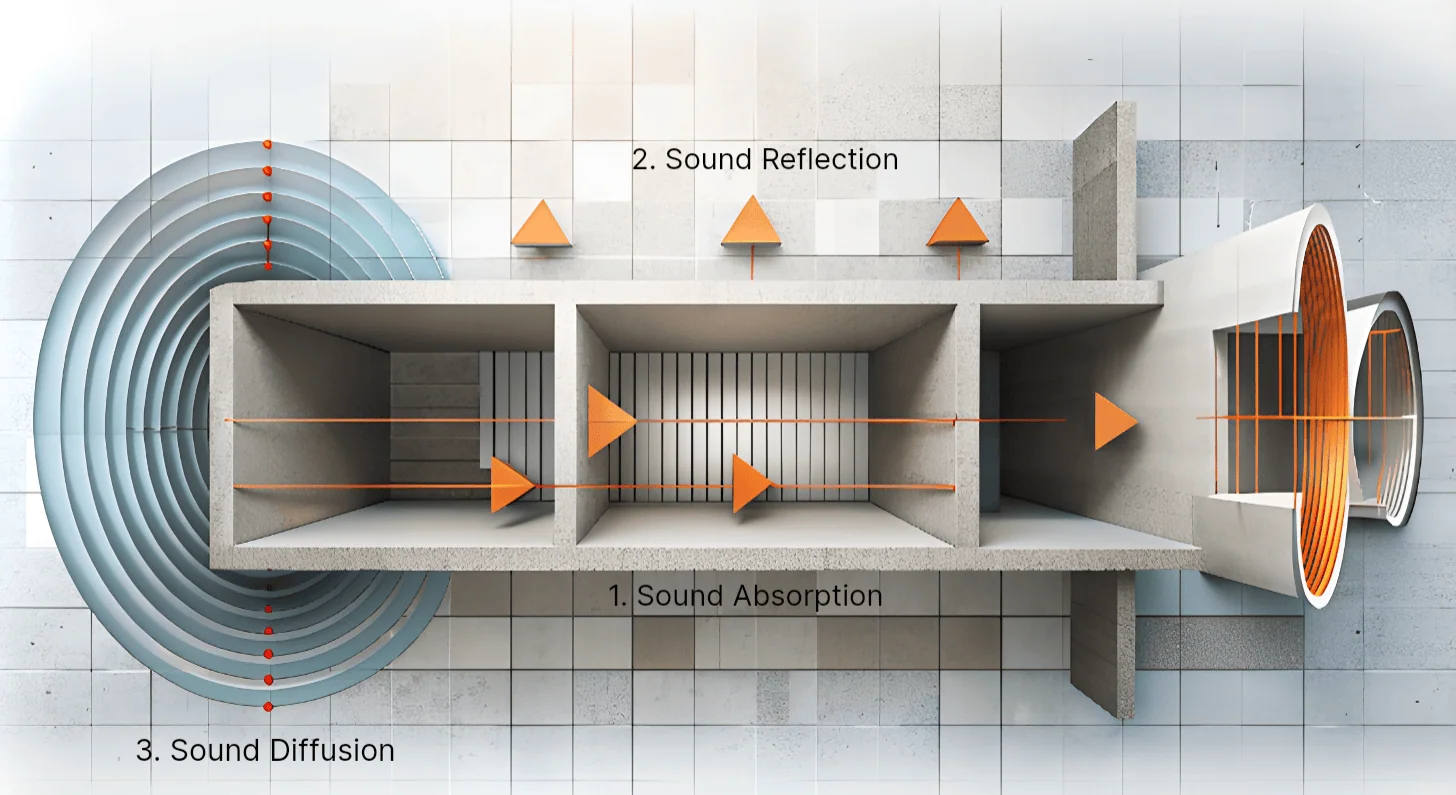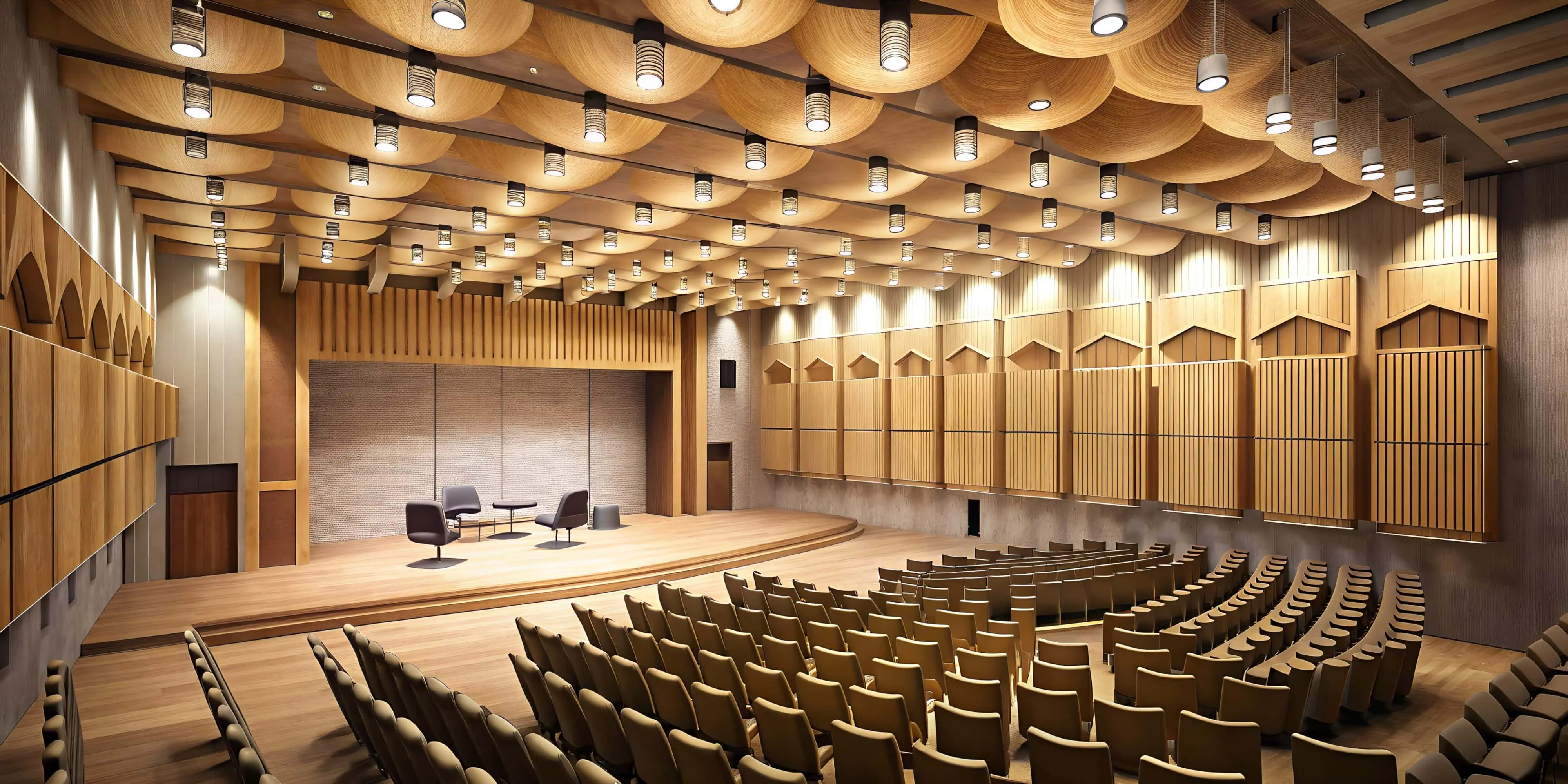Introduction to Architectural Acoustics
Architectural acoustics is a fascinating field that bridges the gap between art and science, playing a pivotal role in the design and construction of buildings. It focuses on controlling sound in buildings to ensure spaces are acoustically pleasing and functional. This field is not just about enhancing sound quality; it’s about creating environments that enhance our daily lives through better sound management.
The importance of architectural acoustics in modern architecture cannot be overstated. As cities grow denser and the demand for multi-functional spaces increases, the need for sophisticated acoustic planning becomes more apparent. It influences everything from the comfort of a residential apartment to the sound clarity in a bustling conference hall.
Leading experts like Christopher Jaffe, an acoustician renowned for his contributions to concert hall designs, highlight the transformational impact of good acoustic design. Jaffe’s work underscores how thoughtfully designed spaces can dramatically improve users’ experiences. Similarly, the ISO 3382 standard provides guidelines for measuring the acoustic quality of spaces, emphasising the scientific approach underlying this artful practice.
The Basics of Sound
Understanding how sound travels and interacts with environments is fundamental to architectural acoustics. Sound is a type of energy that moves through various media—such as air, water, and solids—in the form of waves. When an object vibrates, it causes the surrounding medium to vibrate, propagating sound waves through it.
How Sound Travels
Sound waves can be categorised into three main types:
- Longitudinal Waves: These are the most common type of sound waves and occur when the particle displacement is parallel to the direction of wave propagation. Examples include sound travelling through air or fluids.
- Transverse Waves: In these waves, particle displacement is perpendicular to the direction of wave travel. Although not typically associated with sound in air, they can occur in solid materials where shear can be propagated.
- Surface waves: Travel along the boundary of two different media and can have a combination of longitudinal and transverse motions.
Each type of wave interacts differently with the environment. For instance, when sound waves hit a barrier, some are absorbed, some are reflected, and others may be transmitted through the material, affecting how sound is perceived in a space.

Interactions with Environments
The interaction of sound with an environment involves several key phenomena:
- Reflection: This occurs when sound waves bounce off surfaces, which can lead to echoes or reverberations depending on the surface characteristics and the space’s geometry.
- Absorption: Soft materials may absorb sound waves rather than reflect them, which helps dampen noise and reduce echo.
- Diffraction: Sound waves can bend around obstacles, spreading sound even in areas shadowed from the direct path of the sound wave.
- Refraction: Changes in the medium through which sound travels can bend sound waves, altering their path.
Helpful Resources
For those looking to deepen their understanding of acoustic wall panels and how sound interacts with them, here is a list of our recommendations:
1. Khan Academy
Overview: Khan Academy is a free online educational platform that offers comprehensive tutorials on a wide range of subjects, including physics. The section on sound waves covers the basics of how sound is produced, how it travels, and its properties.
- Pros:
- Accessibility: Free for everyone with internet access.
- User-Friendly: Offers interactive exercises and video tutorials that cater to different learning styles.
- Foundational Knowledge: Great for beginners and those needing a refresher.
- Cons:
- Depth of Content: While excellent for high school and introductory college levels, it may delve deeper than needed for advanced studies or specific professional applications.
2. Academic Journals and Databases (e.g., JSTOR, ScienceDirect)
Overview: These platforms offer access to many academic papers, articles, and textbooks on advanced topics in physics and acoustic engineering. Google Scholar is great for researching in-depth topics.
- Pros:
- Authoritative Information: Provides peer-reviewed and highly detailed studies.
- Cutting-Edge Research: Includes the latest research and developments in the field.
- Cons:
- Accessibility: Many articles require a subscription or access through educational institutions.
- Complexity: The level of detail can be overwhelming for those new to the subject.
3. Textbooks on Physics and Acoustical Engineering
Overview: Standard academic textbooks used in undergraduate and graduate courses can provide a thorough understanding of sound physics, including mathematical models and practical applications.
- Pros:
- Comprehensive Coverage: Detailed discussion on theories, principles, and applications of sound physics.
- Structured Learning: Chapters are usually well-organized and progressively build on concepts.
- Cons:
- Cost: It can be expensive, especially for the most current editions.
- Accessibility: It might not be as readily available or accessible as online resources.
4. MIT OpenCourseWare
Overview: The Massachusetts Institute of Technology offers free course materials for various courses, including physics. Their offerings on acoustics include lecture notes, assignments, and exams.
- Pros:
- High-Quality Resources: Materials are from courses offered at one of the world’s leading technical universities.
- Variety of Materials: Includes lectures, notes, and sometimes video lectures.
- Cons:
- Self-Guided Study: No direct support or interaction with instructors.
- Varied Depth: Some courses are more detailed than others, depending on what was provided online.
These resources provide several paths to deepen your understanding of architectural acoustics and sound physics. Whether you prefer structured academic learning or more flexible, self-paced online tutorials, there’s a resource suited to every learning style and need.

Pioneers and Milestones in Architectural Acoustics
Wallace Clement Sabine – The Father of Architectural Acoustics
Wallace Clement Sabine, a Harvard University professor, is often credited as the founder of architectural acoustics. His groundbreaking work began at the turn of the 20th century when he was tasked with solving the poor acoustics of the Fogg Lecture Room at Harvard.
Key Contributions:
Sabine Equation: Sabine developed the formula to calculate the reverberation time of a room, fundamentally changing the approach to acoustic design. This equation considers the room’s volume and the surfaces’ absorptive properties.
- Practical Applications: His work led to the successful acoustic redesign of Boston’s Symphony Hall, one of the world’s most acoustically perfect halls.
Published Works Reference:
- Sabine’s findings were meticulously documented in his influential paper, The Architectural Acoustics, which remains a foundational text for acoustical engineers and architects alike.

Leo Beranek – Innovator and Educator in Acoustics
Leo Beranek, an American acoustician, significantly impacted the field through both his technical work and his role as an educator. His contributions extended beyond theory into the practical aspects of acoustics in performing arts centres around the world.
Key Contributions:
- Acoustic Design: Beranek’s work on concert hall acoustics, including the design and analysis of how sound propagates in large spaces, has been pivotal. His insights have helped shape the acoustic characteristics of renowned venues such as the Tokyo Opera City Concert Hall and the Vienna Musikverein.
- Legacy and Education: He co-founded Bolt, Beranek, and Newman Inc., which became a leader in acoustical design, and his books have educated generations of acousticians.
Published Works Reference: One of Beranek’s most significant publications, Music, Acoustics & Architecture, revised and expanded as Concert Halls and Opera Houses: Music, Acoustics, and Architecture, provides detailed analyses of 100 auditoriums worldwide, offering valuable insights into what makes a performance space successful acoustically.

Impact and Legacy
Both Sabine and Beranek left indelible marks on architectural acoustics. Their work not only advanced the scientific understanding of sound but also enhanced the practical aspects of architectural design. By addressing the complexities of sound behaviour, they contributed to creating spaces that offer superior auditory experiences.

Critical Components of Architectural Acoustics
Architectural acoustics is a complex field that combines elements of physics, architecture, and design to manage how sound behaves in an enclosed space. The primary components of architectural acoustics include sound absorption, reflection, and diffusion. Each plays a vital role in how sound is perceived in a room or building, influencing everything from the clarity of speech in a classroom to the quality of music in a concert hall.
1. Sound Absorption
Sound absorption is critical in controlling echo and reverberation in architectural spaces. Materials that absorb sound help reduce noise levels, minimise sound reflections, and significantly improve a space’s acoustic quality.
Applications:
- Acoustic Panels: These are used in recording studios and theatres to absorb excess sound and prevent echoes.
- Carpeting and Curtains: Soft materials in offices and homes help absorb sound, making conversations clearer and reducing noise pollution.
2. Sound Reflection
Reflection is another essential component of architectural acoustics. Hard surfaces can reflect sound waves, which can be beneficial and detrimental, depending on the design goals.
Applications:
- Concert Halls: Carefully designed hard surfaces help reflect sound waves towards the audience, enhancing the clarity and volume of the music.
- Public Speaking Venues: Strategic placement of reflective surfaces can aid in the projection of sound, ensuring that speech reaches all areas of the audience effectively.
3. Sound Diffusion
Sound diffusion is about scattering sound energy, preventing the formation of acoustic hot spots and dead zones in a space. Diffusion helps achieve a more uniform sound field, which is particularly important in larger or irregularly shaped spaces.
Applications:
- Diffusive Architectural Elements: Specially designed walls and ceilings in auditoriums and performance spaces help to scatter sound evenly throughout the space.
- Furniture and Decor: Objects like bookshelves, plants, and decorative elements naturally diffuse sound, contributing to better sound quality in living spaces.
By integrating these key components of architectural acoustics into the design process, architects and designers can create spaces that meet the functional requirements of sound management and enhance the overall auditory experience. Understanding and applying the principles of sound absorption, reflection, and diffusion is essential in achieving optimal acoustic environments.

Design Principles in Architectural Acoustics
Architectural acoustics encompasses more than just the basic understanding of sound properties; it involves meticulous design and material selection to tailor the acoustic environment. These design principles ensure that every space, whether a tiny recording studio or a sprawling concert hall, meets its specific sound requirements.
Spatial Design and Its Impact on Acoustics
The shape and size of a space are crucial in determining its acoustic properties. Different spatial designs influence sound waves differently, affecting everything from echo to sound clarity.
Examples:
- Shoebox Design: Classic concert halls like the Vienna Musikverein employ a rectangular “shoebox” design. This shape is renowned for promoting optimal sound distribution and warmth, enhancing both clarity and reverberation in a balanced manner.
- Vineyard Style: The Berlin Philharmonic is an example of a vineyard-style concert hall, where the audience surrounds the stage, creating more intimate and engaging listening experiences.
Technical Names and Styles:
- Shoebox Style (Rectangular Halls)
- Vineyard Style (Surround Halls)
- Fan-Shaped and Arena Configurations
These configurations are detailed in academic papers such as those found in the Journal of Acoustical Society of America, which examine the impact of architectural design on auditorium acoustics.
Material Selection for Optimal Sound Control
Choosing the right materials is vital for effective sound management. Materials affect sound absorption, reflection, and diffusion; thus, their selection is integral to acoustical design.
Examples:
- Absorptive Materials: Soft materials like acoustic foam or heavy curtains are used in recording studios to prevent echo and manage reverberations.
- Reflective Materials: Hard surfaces like wood or plaster are commonly used in concert halls to enhance sound reflection and ensure that music carries throughout the space.
By applying these principles, architects and designers can significantly enhance the acoustic performance of a space. The thoughtful integration of spatial design and material selection based on solid acoustic theory and empirical research ensures that each space not only meets its functional needs but also provides an optimal auditory experience.
Recent Innovations in Architectural Acoustics
Architectural acoustics is an ever-evolving field, with new technologies and design approaches continuously emerging to enhance the auditory environments of both indoor and outdoor spaces. Cutting-edge projects around the world demonstrate the innovative application of acoustical design principles, transforming how we experience sound in urban environments.
Cutting-Edge Projects and Technologies
Elbphilharmonie, Hamburg
The Elbphilharmonie in Hamburg is not only an architectural icon but also a marvel of modern acoustical engineering. Designed by Herzog & de Meuron, this concert hall is famed for its unique undulating glass structure and an interior that houses one of the most acoustically advanced auditoriums in the world.
Acoustic Features:
- Custom-Designed Reflective Panels: The main concert hall is equipped with 10,000 individually shaped gypsum fibre panels that reflect sound to every corner, ensuring perfect acoustics regardless of seat location.
- Innovative Use of Space: The hall is designed to provide vineyard-style seating, where the audience surrounds the stage, enhancing the immersive sound experience.
For more insights into Elbphilharmonie’s acoustic design, you can visit architectural reviews or the official Elbphilharmonie Hamburg overview.

Jewel Changi Airport, Singapore
Singapore’s Jewel Changi Airport is another exemplary project where architectural acoustics play a central role. Beyond its stunning visual design, it features an environment where sound management is crucial due to the vast, open spaces filled with retail, dining, and park areas.
Acoustic Features:
- Soundscaping: The use of soundscaping techniques to create peaceful zones amidst the busy airport environment.
- Architectural Materials: Special materials manage the acoustics in this multi-use space, ensuring that noise levels are controlled and speech intelligibility is maintained across different zones.
A detailed discussion of Jewel Changi’s acoustic strategies can be found at https://www.arup.com/projects/jewel-changi-airport.

Impact on Urban Soundscapes
These innovations demonstrate how thoughtful acoustical design can greatly improve the quality of urban life. By incorporating advanced acoustic technologies and materials, these projects not only address noise pollution but also enhance the aesthetic and functional qualities of urban spaces.
Advanced projects like these are setting new standards in architectural acoustics, showing that it’s possible to beautifully blend function and form while creating sound environments that are enjoyable and conducive to their specific urban contexts.
Career Pathways in Architectural Acoustics
A career in architectural acoustics offers the opportunity to merge science with design, creating environments that enhance auditory experiences. Acoustical consultants, particularly in Ireland, play a crucial role in a variety of projects, from residential developments to large-scale commercial constructions.
Role of an Acoustical Consultant in Ireland
Acoustical consultants in Ireland are involved in assessing, managing, and controlling sound and vibrations in various environments. Their work ensures that buildings and projects comply with sound regulations and meet the highest standards for acoustic performance.
Key Responsibilities:
- Design and Analysis: Developing acoustical models and designing solutions to optimise sound quality in different settings.
- Site Assessment: Conducting noise surveys and sound level assessments to inform design decisions.
- Compliance and Regulation: Ensuring that projects adhere to local and national acoustics-related regulations.
Necessary Skills and Qualifications
To succeed as an acoustical consultant, several skills and qualifications are essential:
- Educational Background: A degree in acoustics, engineering, physics, or a related field is typically required. Advanced degrees may be necessary for higher-level positions.
- Technical Skills: Proficiency in acoustical modelling software and sound measurement equipment, as well as an understanding of building design and materials.
- Soft Skills: Strong analytical abilities, problem-solving skills, and effective communication are crucial.
How to Get Started and Educational Pathways
Embarking on a career in architectural acoustics usually begins with education. Prospective acoustical consultants should aim for relevant undergraduate and potentially postgraduate studies.
Educational Institutions:
- Institute of Acoustics: Based in the UK, they offer courses that are well-regarded internationally, including a Diploma in Acoustics and Noise Control that is often a requisite for consulting roles.
- Trinity College Dublin: Offers courses and research opportunities in engineering disciplines that can be tailored towards acoustics.
Professional Certifications:
- Membership in the Institute of Acoustics (IoA): This is highly beneficial for professional credibility and networking. The IoA provides resources, networking opportunities, and certifications that are recognised in Ireland and internationally.
For more information on courses and certifications, you can visit the Institute of Acoustics website or the Trinity College Dublin engineering page.
Conclusion
With urban spaces becoming denser and noise pollution increasing, the demand for skilled acoustical consultants is expected to grow, not just in Ireland but globally. A career in architectural acoustics not only offers the chance to improve the quality of living environments but also provides a pathway into a profession that blends technical skills with creative design solutions.


